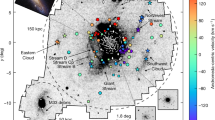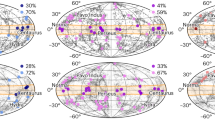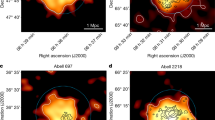Abstract
II. IN the first part of this article the main characteristics of the globular and open clusters were discussed, and it was shown bow the determination of their distances led to the proposal of extremely great dimensions for the galactic system. A theory of the origin and structure of the Galaxy also seems to be indicated by the observations.
This is a preview of subscription content, access via your institution
Access options
Subscribe to this journal
Receive 51 print issues and online access
$199.00 per year
only $3.90 per issue
Buy this article
- Purchase on Springer Link
- Instant access to full article PDF
Prices may be subject to local taxes which are calculated during checkout
Similar content being viewed by others
REFERENCES
Lund Meddelanden, Series 2, No. 19.
Bul. Nat. Research Council, No. 11, p. 174.
Proc. Acad. Sci. Amsterdam, 20, p. 1108; 21, p. 36.
Mt. W. Contr. 155, and 175, P. 11.
I first tried out the method six years ago (Mt. W. Contr. 116, p. 81), but abandoned it as wholly unsuited to the brighter stars in globular clusters. The Kapteyn luminosity curves for separate spectral types, however, may be of high value.
Bul. Ast. Inst. Neth., No. 8.
Kapteyn and van Rhijn state that eight Cepheids of long period are known in two globular clusters. In my paper from which they get their data (Mt. W. Contr. 151) I show that twelve long-period Cepheids occur in the five globular clusters Messier 3, 5, 13, 15, and Omega Centauri. Four of these clusters contain also large numbers of short-period Cepheids only one or two magnitudes fainter than the long-period Cepheids. Unpublished results obtained at Harvard show that long-period Cepheids occur in other globular clusters.
Mt. W. Contr. 153, Mt. W. An. Rep. for 1918, and elsewhere.
Russell, Astroph. Jour. 54, p. 140.
Observatory, May 1922.
Bul. Nat. Research Council, No. 11, p. 184, 190.
The photovisual magnitudes for Messier 11, however, are probably affected by a serious scale error; the colour indices do not agree with the spectra subsequently determined (Mt. W. Contr. 120 and 228).
Mt. W. Commun. 62, p. 6; cf. also Hubble, Mt. W. An. Rep. for 1922, p. 251.
Mt. W. Contr. 115, p. 12, 125, p. 10, and 161, p. 13.
Mt. W. Contr. 156, p. 5.
Harv. Bul. 763.
Mt. W. Contr. 156, p. 5, and 157, p. 14.
Zeits. für Physik, 7, p. 390.
Mon. Not. R.A.S. 79, p. 19.
This conclusion may not hold for close double stars, as certain results from eclipsing binaries are not in full agreement; the less dense, dark companion is believed to be, frequently, less massive and also less developed than its primary.
Harv. Bul. 765; Proc. Nat. Acad. Sci. 8, p. 69.
Pub. Ast. Soc. Pac., October 1919.
Mt. W. Contr. 213 and 214.
Mt. W. Contr. 156, p. 12; cf. Graff, Ast. Nach. 5133.
Jour. of Geol. 29, p. 502.
The annual number brighter than the tenth magnitude actually exceeds forty, according to Bailey's data. Pub. Am. Ast. Soc. 4, p. 248.
Rights and permissions
About this article
Cite this article
SHAPLEY, H. The Galactic System1. Nature 110, 578–581 (1922). https://doi.org/10.1038/110578a0
Issue Date:
DOI: https://doi.org/10.1038/110578a0
Comments
By submitting a comment you agree to abide by our Terms and Community Guidelines. If you find something abusive or that does not comply with our terms or guidelines please flag it as inappropriate.



